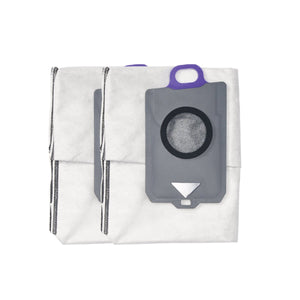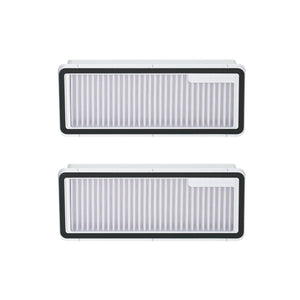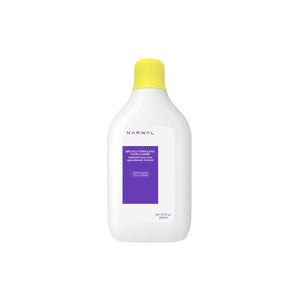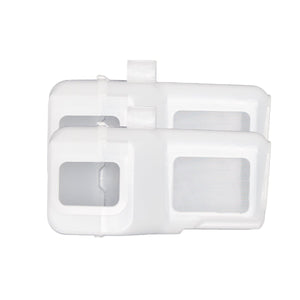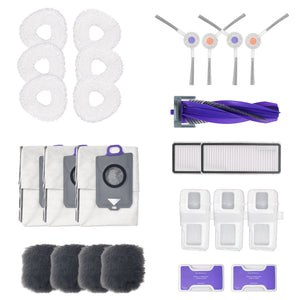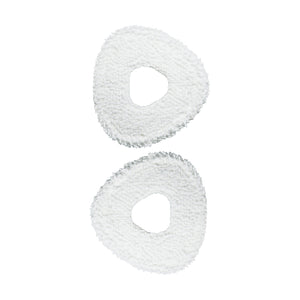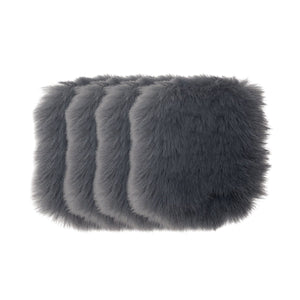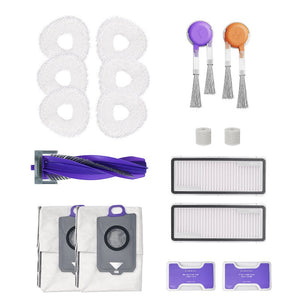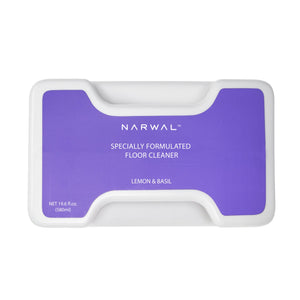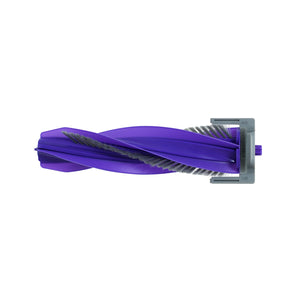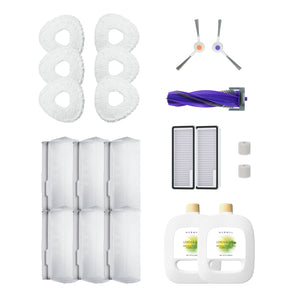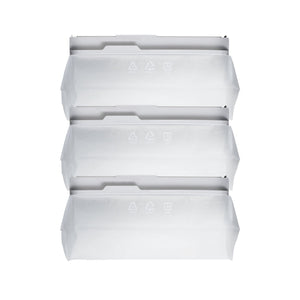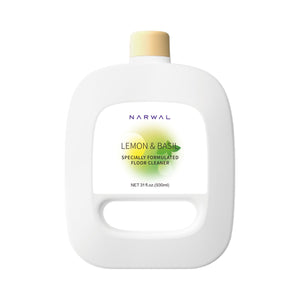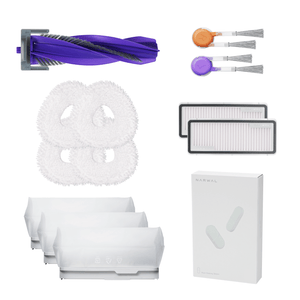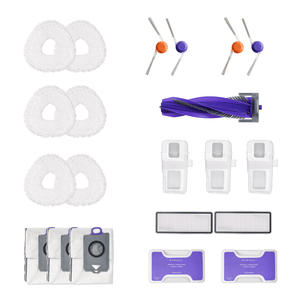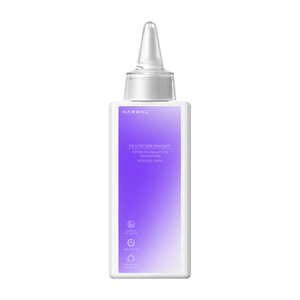Tired of your robot vacuum getting stuck under the couch or tangled on a rug? You’re not alone — nearly half of robot vacuum owners face this problem weekly. In this guide, we’ll explain why robot vacuums get stuck, how to fix the issue, and what to do to prevent it for good. From simple cleaning tips to smart navigation tech like Narwal Flow, you’ll learn how to keep your vacuum moving smoothly every time.
What Are the Common Reasons Robot Vacuums Get Stuck?
Robot vacuums often get stuck due to obstacles in their path, getting caught on furniture, difficulty navigating different floor types, issues with cleaning certain surfaces, and battery or charging problems. By identifying and addressing these issues, you can help ensure your robot vacuum operates smoothly.

Obstacles and Barriers That Cause Robot Vacuums to Get Stuck
Robot vacuums often get stuck on loose wires, small toys, and uneven floor transitions. These obstacles can stop the vacuum, cause it to get stuck, or even damage it. To prevent this, clear the path of any potential barriers before starting the cleaning cycle.
Making sure your vacuum has a clear path can greatly reduce the likelihood of it getting stuck.
Why Robot Vacuums Often Get Stuck Under Furniture

Furniture and low-lying objects like chairs, beds, and sofas can trap the vacuum underneath or cause it to jam. Loose rugs, floor mats, and low-hanging drapes can also entangle the vacuum. To avoid these issues, keep the floor clear of such objects.
Floor Transitions That Make Robot Vacuums Get Stuck
Transitions between different floor types, such as from hardwood to carpet or tile to rugs, can be challenging for some robot vacuums. Significant height differences, thick carpets, or uneven tiles can cause the vacuum to get stuck. Ensuring smooth transitions between floor types can help the vacuum navigate more effectively.
Surface Issues: When Vacuums Struggle on Hardwood or Carpets

Debris on hardwood floors can cause the vacuum's wheels to lose traction, leading to it getting stuck. Thick or high-pile carpets can tangle the vacuum's brushes and wheels, causing it to stop unexpectedly. Keeping floors clear and maintaining the vacuum can help prevent these issues.
Battery or Charging Problems That Stop Cleaning Midway

A low battery during a cleaning cycle can cause the vacuum to stop in the middle of a room. Poor battery health or an inaccessible charging dock can also lead to incomplete charges. Ensuring a healthy battery and properly positioning the charging dock can help prevent the vacuum from getting stuck due to power issues.
Why Does My Robot Vacuum Stop Mid-Clean?
Sometimes a robot vacuum stops cleaning halfway through a cycle, even when the battery is not fully drained. This issue is usually caused by navigation errors, blocked sensors, or an incomplete mapping process. If the robot loses its orientation or misreads its surroundings, it may pause or return to the dock prematurely.
Make sure the sensors and wheels are clean, and restart the cleaning process in a well-lit, open area. Allow the robot to complete one full cycle so it can rebuild an accurate map of your home.
Narwal robot vacuums minimize this issue through smart navigation and automatic recharge-return technology, allowing them to continue cleaning seamlessly once recharged.
How to Fix a Robot Vacuum That Gets Stuck
Most robot vacuum issues and solutions start with simple checks. If your robot vacuum often gets stuck during cleaning, there are a few clear steps you can follow to identify and fix the issue. These actions are practical and can help most models, including Narwal, resume normal operation without service support.
Step 1 – Stop and Inspect the Vacuum
When your robot stops or struggles to move, pause or turn it off immediately. Look around the area to identify possible obstacles such as cords, rug edges, or uneven surfaces. Gently lift the vacuum and check whether something is trapped underneath or around the wheels or brushes. Avoid pulling or forcing the unit free, as this could damage the sensors or the drive system.
Step 2 – Check for Physical Obstructions
Flip the vacuum over and carefully inspect the bottom. Remove any hair, string, or debris wrapped around the side brushes, main roller, or wheels. Pay attention to areas around the bumper and suction inlet, as dust can collect there and interfere with movement. Use the cleaning brush provided with your vacuum, or a soft cloth, to remove buildup.
Step 3 – Clean the Sensors and Wheels
Dirty sensors are one of the most common reasons robot vacuums get stuck or spin in place. Wipe each sensor with a soft, dry cloth, especially those located on the underside and near the front bumper. Clean the wheels and ensure they can spin freely without friction or resistance. If needed, use a small brush to clear dust from around the wheel mounts and axles.
Step 4 – Reset or Recalibrate Navigation
If your robot repeatedly gets stuck in the same locations, its navigation map may need to be reset. Open the app and clear the existing map. Run a full mapping session with doors open and the area well lit. Updating the firmware can also improve obstacle detection and route planning. After recalibration, allow the robot to complete a full cleaning cycle to rebuild accurate navigation data.
Step 5 – Test in a Controlled Area
Before returning the vacuum to its normal schedule, test it in a small, open space. Watch how it handles edges, furniture legs, and transitions between floor types. If it moves smoothly and completes the area without interruption, the problem is likely resolved.
Step 6 – When to Contact Support or Service
If your robot still gets stuck frequently after cleaning and recalibration, there may be a mechanical or sensor fault. Check the manufacturer’s troubleshooting guide for model-specific error messages or diagnostic codes. For Narwal models, in-app support can help analyze the problem and provide guided solutions or service recommendations.
How to Prevent Robot Vacuum from Getting Stuck (Pro Tips)

Clear the Floor of Obstacles Before Each Cleaning Cycle
Before starting a cleaning cycle, pick up items like toys, shoes, and loose cables that could obstruct the vacuum's path. A clear floor helps the vacuum clean efficiently and reduces the risk of it getting stuck.
Use Virtual Walls and Magnetic Strips to Block Problem Areas
Set up virtual walls and magnetic strips to create invisible barriers. This keeps the vacuum away from problem areas, such as rooms with lots of furniture or cords. Strategically placed boundaries help direct the vacuum along a safe and efficient path.
Raise Furniture or Create Barriers Around Tight Spaces

Raise low-lying furniture with risers or blocks to give the vacuum enough clearance to pass underneath. Additionally, create barriers around areas where the vacuum frequently gets stuck, like near cords or tight spaces, to guide it along a clear path.
Adjust Cleaning Settings Based on Floor Type
Tailor the vacuum's settings to your flooring type. Use "carpet boost" for carpets or lower suction for delicate floors. Cleaning in a systematic pattern rather than randomly can help the vacuum navigate more efficiently.
Perform Regular Maintenance for Optimal Performance
Routinely empty the dustbin, clean the brushes and check the wheels for debris. This ensures peak performance and prevents the vacuum from getting stuck due to clogged brushes or full dustbins. Clean the sensors to maintain accurate navigation.
Update Software to Improve Navigation and Obstacle Detection
Keep the vacuum's software up-to-date. Firmware updates improve navigation algorithms and obstacle detection. Regularly check for updates via the vacuum’s app or manufacturer’s website to ensure optimal performance and reduce the chances of it getting stuck.
Robot Vacuum Stuck Error Codes Explained
Many robot vacuums display error codes when they get stuck or experience technical issues. These codes help users identify what went wrong and how to fix it. While specific meanings can vary by brand, most manufacturers follow a similar pattern. Below are some of the most common error codes found in many robot vacuum models (not specific to Narwal products).
E1 — Wheel Jammed
Indicates that one or both drive wheels are blocked by debris or tangled hair.Flip the robot over and check for any obstructions around the wheels and side brushes.
E2 — Cliff Sensor Error
The cliff or drop sensors may be dirty, covered, or misaligned. Wipe the sensors gently with a soft, dry cloth and restart the robot in a well-lit area.
E3 — Navigation or Path Error
The robot may have lost its position or encountered a complex layout. Try resetting the map or running the cleaning cycle again with doors open and good lighting.
E4 — Suction or Airflow Blocked
Dust buildup or a clogged filter may be preventing airflow. Empty the dustbin, clean the filters, and check the suction port for blockages.
E5 — Battery or Charging Fault
The robot cannot complete charging or detects a power interruption. Make sure the charging contacts are clean and the dock is placed on a flat surface.
Important Note About Narwal Vacuums
Narwal robot vacuums do not use numerical error codes like “E1” or “E2.” Instead, they rely on light and voice indicators to communicate system status or troubleshooting needs. For example, a red flashing light typically means an error or obstruction, while a voice prompt will describe the exact issue such as “Please check the wheels.” All Narwal alerts can also be viewed in the Narwal app, which provides step-by-step troubleshooting guidance for each condition.
Error codes are a quick way for many robot vacuums to communicate problems such as wheel jams, sensor faults, or power issues. While these examples are common across multiple brands, Narwal takes a different approach with intuitive voice and light-based alerts, making it easier for users to identify and resolve issues without memorizing codes.
Why Narwal Vacuums Rarely Get Stuck: Inside Their Smart Navigation Tech
Many robot vacuums stop when they run into rugs, cords, or furniture. Narwal Flow is different. It uses smart eyes and a quick brain to move safely around your home. The robot sees obstacles before touching them and plans a new path right away, so it keeps moving instead of getting stuck.
Its TwinAI system has two RGB cameras and an AI chip that help it recognize more than 200 everyday objects, such as toys, cables, and table legs. Flow can tell what’s in the way and steer around it smoothly without bumping or pausing.
When the robot detects a carpet, it activates CarpetFocus Technology. It increases suction to pull dirt from deep inside the fibers and lifts its mop by 12 millimeters to keep the carpet dry. This lets it move easily from hard floors to rugs without stopping or dragging.
Flow also uses a DualFlow Tangle-Free System to stop long hair from wrapping around the brushes. Its EdgeReach Mop stretches close to walls and corners, cleaning spots that most vacuums miss while keeping a safe distance from obstacles.
In short, Narwal Flow doesn’t just clean—it learns. It sees the space, avoids trouble, and adjusts its cleaning path in real time. That’s why it keeps going, even in homes full of furniture, cables, and rugs.
[cta:flow-robot-vacuum-and-mop]

Conclusion
Preventing your robot vacuum from getting stuck is easier than you think. Clear obstacles, use virtual walls, adjust settings, and maintain your vacuum regularly. Keep the software updated for optimal performance. Apply these tips now and enjoy a smooth, uninterrupted cleaning experience. Ready to make your cleaning routine stress-free? Start today!
FAQs
Do all robot vacuums get stuck?
Not all robot vacuums get stuck, but many can encounter obstacles depending on the environment. Modern models have advanced navigation systems to minimize this issue.
How many years do robot vacuums last?
Robot vacuums typically last between 3 to 5 years with proper maintenance. Battery life and usage frequency are key factors affecting longevity.
Do robot vacuums get stuck on rugs?
Some robot vacuums can get stuck on rugs, especially if they have tassels or high-pile fibers. Models with better sensors and navigation features handle rugs more effectively.




















